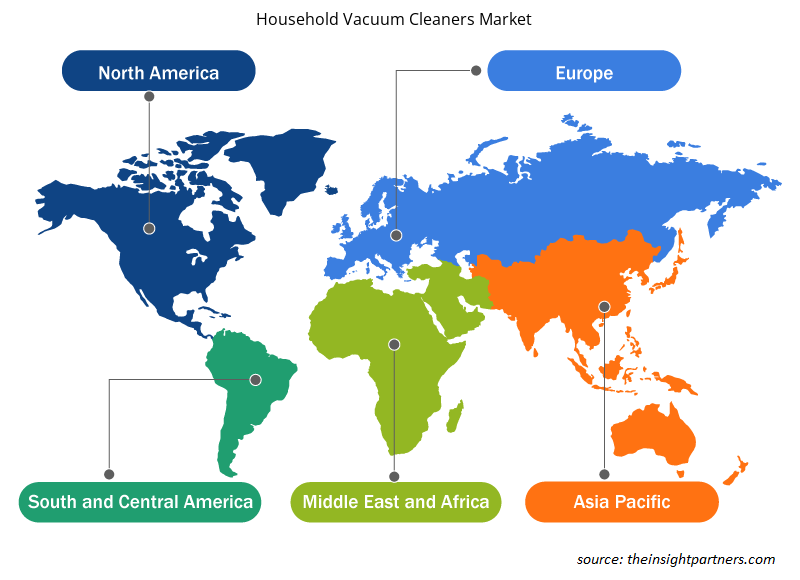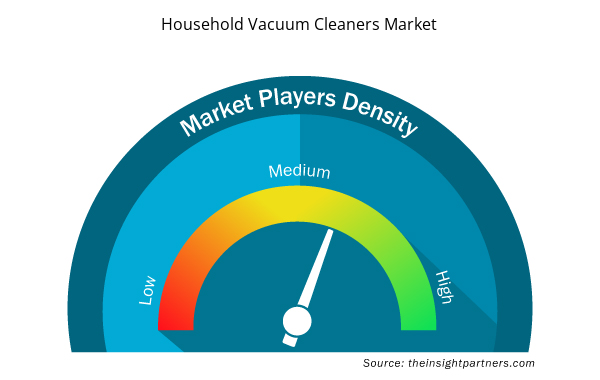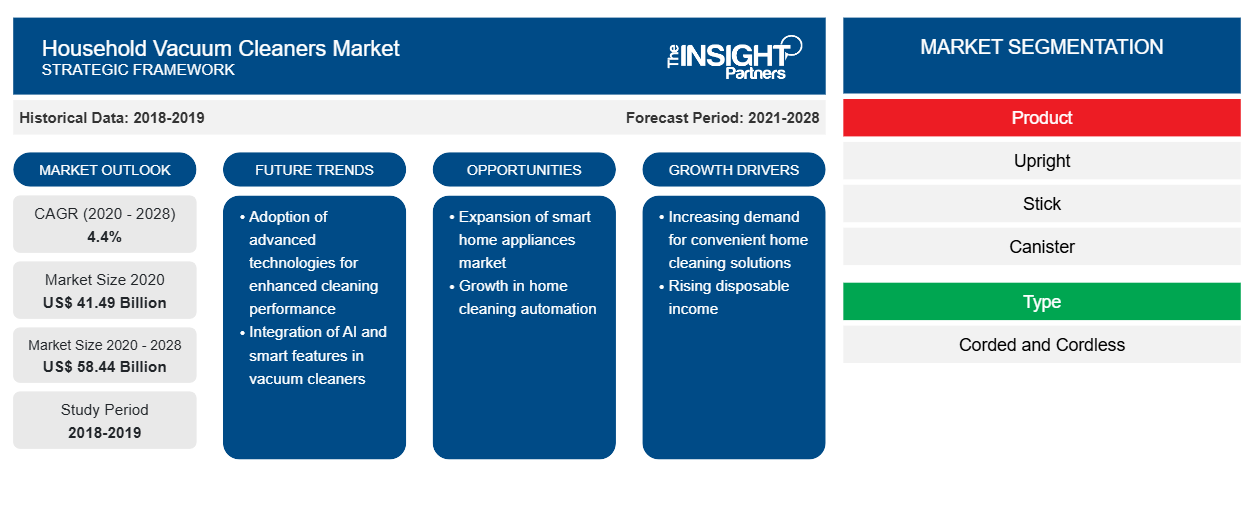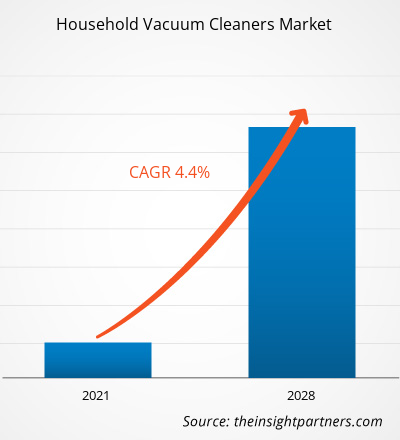家庭用掃除機市場は2020年に414億9,090万米ドルと評価され、2028年までに584億3,960万米ドルに達すると予測されており、2021年から2028年にかけて4.4%のCAGRで成長すると予想されています。
家庭用掃除機は、吸引力を利用して床、布張りの家具、カーテン、その他の表面からゴミを掃除して除去するために使用される電気家電です。家庭用掃除機には、さまざまなサイズと形状があり、直立型、キャニスター型、手持ち型、ロボット型など、さまざまなタイプのモデルがあります。便利で使いやすく、効率的な掃除を実現するために、家庭用掃除機はコードレスで持ち運び可能で、持ち運んで家のさまざまな場所を掃除するために使用できます。
アジア太平洋地域は、予測期間中に家庭用掃除機市場が最も急速に成長する地域であると同時に、支配的な地域でもあります。この地域は、ユーレカ フォーブス、ハイアール、ダイソン、コーニンクレッカ フィリップス NV などの家庭用掃除機の大手メーカーの中心地であり、アジア太平洋地域の家庭用掃除機市場にさまざまな成長の機会を提供します。多忙な仕事生活スケジュールと長時間労働により、家事中の家庭の手作業を軽減するスマート家電の需要が高まっています。これに伴い、消費者の好みが従来の掃除方法から近代化された掃除方法に移行していることが、アジア太平洋地域の家庭用掃除機市場の成長を牽引しています。この地域の急速な都市化に伴う可処分所得の増加が、アジア太平洋地域の家庭用掃除機市場を牽引しています。近代化された掃除方法に対する消費者の好みに加えて、家庭の衛生に関する意識の高まり、および時間を節約するための日常の活動の自動化の傾向の高まりが、アジア太平洋地域の家庭用掃除機市場に有利な機会を提供しています。
COVID-19のパンデミックにより、家庭用掃除機市場の状況は劇的に変化しました。このパンデミックにより、国境や国境が突然閉鎖されたため、業務効率が低下し、バリューチェーンが中断され、収益の損失と損害が発生しました。バリューチェーンの混乱により原材料の供給が制限され、それが市場の成長を妨げ、最終用途産業の発展に影響を与えています。しかし、経済が事業の復活を計画しているため、今後数か月で家庭用掃除機の需要が世界的に高まると予想されています。COVID-19の流行により、国民の間で清潔さと衛生習慣の重要性が強調されました。欧州疾病予防管理センターのマイクロラーニングコースによると、SARSCoV-2ウイルス粒子が空気によって移動し、他の表面に付着する可能性があるという証拠があります。したがって、床の清掃が不可欠になります。そのため、Oreck は、軽量で持ち運び可能で、強力で優れた吸引力を備え、部屋の汚れを簡単に取り除くことができるハンディ型およびキャニスター型の掃除機を提供しています。Oreck のキャニスター型掃除機の中には、ほこりや汚れ、その他のアレルゲンを捕らえて閉じ込める HEPA フィルターを備えたものもあります。そのため、汚れが家の中に戻らないようにすることができます。掃除機をかけても SARS-CoV-2 は除去できませんが、ウイルス粒子が空気中に放出されにくくなり、吸い込んだり、よく触れる表面に運ばれたりすることがなくなります。ただし、掃除機をかけると、ゴミやほこり、その他の粒子を捕らえて保持できるため、ウイルスの量を大幅に減らすことができます。これらのすべての要因により、今後数年間で家庭用掃除機の需要が世界的に高まると予想されています。
要件に合わせてレポートをカスタマイズする
このレポートの一部、国レベルの分析、Excelデータパックなど、あらゆるレポートを無料でカスタマイズできます。また、スタートアップや大学向けのお得なオファーや割引もご利用いただけます。
- このレポートの主要な市場動向を入手してください。この無料サンプルには、市場動向から見積もりや予測に至るまでのデータ分析が含まれます。
市場分析
衛生維持のために掃除機が好まれる傾向が高まっている
家の掃除は、家庭の衛生と清潔さを保つための従来の方法として、手作業で行われてきました。しかし、家庭用掃除機を使えば、従来の掃除方法に比べて、より効果的に、より短時間で掃除することができます。しかし、家庭での掃除機の必要性は、掃除だけにとどまらず、今日では、環境を無菌に保つためにも掃除機が使われるようになっています。掃除機は、床を掃除するためのより優れた、より効果的な手段を提供するだけでなく、空気を浄化する役割も果たします。企業は、機械のエネルギー効率と性能をさらに高めるために、高度なモーター技術を搭載した新しい家庭用掃除機を導入するために、研究開発に投資しています。たとえば、2019年9月、ミーレは、高効率微粒子吸収(HEPA)フィルターを内蔵した新しいコードレス家庭用掃除機を発表しました。HEPAフィルターは、室内の空気の質を大幅に向上させ、空気中の汚染物質の放出を防ぐことで、アレルギーや喘息の可能性を減らします。その結果、衛生を保つための家庭用掃除機の需要が高まり、市場の成長を牽引しています。
タイプインサイト
タイプに基づいて、家庭用掃除機市場はコード付きとコードレスに分かれています。2020年には、コード付き掃除機セグメントが家庭用掃除機市場を支配しました。コード付き掃除機は、主電源に接続するため、高い吸引力を備えています。アップライト、スティック、ウェット&ドライ、キャニスター掃除機は、コード付きのバリエーションで提供されている主な製品です。コード付き掃除機は、広いスペースを掃除するのに適しています。コード付き掃除機の集塵容量は、コードレスのものよりも高くなっています。コード付き掃除機は、ある程度まで持ち運び可能で、ポータブルコード付き掃除機には、約16フィートの電源コードを備えたEureka Forbesマルチクリーン掃除機など、かなり長い電源コードが付いています。コードを巻き取ることは、このタイプのクリーナーを使用する際に消費者が直面する大きな問題の1つです。
家庭用掃除機市場で活動している主要な市場プレーヤーには、BISSELL、Electrolux、Koninklijke Philips NV、Stanley Black & Decker、Inc.、Haier Group、Dyson Limited、Eureka Forbes、Groupe SEB、Miele、Oreck Corporation などがあります。市場の主要プレーヤーは、地理的プレゼンスと消費者ベースを拡大するために、合併や買収、製品の発売などの戦略に重点を置いています。
レポートの注目点
- 家庭用掃除機業界の進歩的なトレンドは、プレーヤーが効果的な長期戦略を策定するのに役立ちます
- 先進国市場と発展途上国市場での成長を確保するために企業が採用する事業成長戦略
- 2019年から2028年までの世界の家庭用掃除機市場の定量分析
- さまざまな業界における家庭用掃除機の需要の推定
- 市場の成長を予測するために業界で活動するバイヤーとサプライヤーの有効性を示すPEST分析
- 競争市場シナリオと家庭用掃除機の需要を理解するための最近の動向
- 家庭用掃除機市場の成長を牽引・抑制する要因と市場動向および見通し
- 世界の家庭用掃除機市場の成長に関する商業的関心を支える戦略を理解し、意思決定プロセスを支援する
- 家庭用掃除機の市場規模と市場のさまざまなノード
- 世界の家庭用掃除機市場の詳細な概要とセグメンテーション、およびその業界動向
- 有望な成長機会があるさまざまな地域の家庭用掃除機市場規模
家庭用掃除機市場の地域別分析
予測期間を通じて家庭用掃除機市場に影響を与える地域的な傾向と要因は、Insight Partners のアナリストによって徹底的に説明されています。このセクションでは、北米、ヨーロッパ、アジア太平洋、中東、アフリカ、南米、中米にわたる家庭用掃除機市場のセグメントと地理についても説明します。

- 家庭用掃除機市場の地域別データを入手
家庭用掃除機市場レポートの範囲
| レポート属性 | 詳細 |
|---|---|
| 2020年の市場規模 | 414.9億米ドル |
| 2028年までの市場規模 | 584.4億米ドル |
| 世界のCAGR(2020年 - 2028年) | 4.4% |
| 履歴データ | 2018-2019 |
| 予測期間 | 2021-2028 |
| 対象セグメント | 製品別
|
| 対象地域と国 | 北米
|
| 市場リーダーと主要企業プロフィール |
|
家庭用掃除機市場のプレーヤー密度:ビジネスダイナミクスへの影響を理解する
家庭用掃除機市場は、消費者の嗜好の変化、技術の進歩、製品の利点に対する認識の高まりなどの要因により、エンドユーザーの需要が高まり、急速に成長しています。需要が高まるにつれて、企業は提供品を拡大し、消費者のニーズを満たすために革新し、新たなトレンドを活用し、市場の成長をさらに促進しています。
市場プレーヤー密度とは、特定の市場または業界内で活動している企業または会社の分布を指します。これは、特定の市場スペースに、その規模または総市場価値と比較して、どれだけの競合相手 (市場プレーヤー) が存在するかを示します。
家庭用掃除機市場で事業を展開している主要企業は次のとおりです。
- ビッセル
- エレクトロラックス
- フィリップスNV
- スタンレーブラックアンドデッカー社
- ハイアールグループ
免責事項:上記の企業は、特定の順序でランク付けされていません。

- 家庭用掃除機市場のトップキープレーヤーの概要を入手
家庭用掃除機市場(製品別)
- 直立
- キャニスター
- ハンドヘルド
- ロボット
- スティック
- その他
家庭用掃除機市場(タイプ別)
- コード付き
- コードレス
家庭用掃除機市場、流通チャネル別
- オフライン
- オンライン
企業プロフィール
- ビッセル
- エレクトロラックス
- フィリップスNV
- スタンレーブラックアンドデッカー社
- ハイアールグループ
- ダイソン株式会社
- ユーレカフォーブス
- SEBグループ
- ミーレ
- オーレック株式会社
- 過去2年間の分析、基準年、CAGRによる予測(7年間)
- PEST分析とSWOT分析
- 市場規模価値/数量 - 世界、地域、国
- 業界と競争環境
- Excel データセット



Report Coverage
Revenue forecast, Company Analysis, Industry landscape, Growth factors, and Trends

Segment Covered
This text is related
to segments covered.

Regional Scope
North America, Europe, Asia Pacific, Middle East & Africa, South & Central America

Country Scope
This text is related
to country scope.
よくある質問
Robotic vacuum cleaners are smart devices that handle cleaning chores with just a single click. These devices are a perfect choice for people that cannot make time for sweeping and cleaning. The robotic vacuum cleaners move around the house autonomously while collecting the dust and debris present on surfaces into an attached dustbin. These vacuum cleaners navigate around the furniture and come back to their docking station to recharge their batteries. The ease of usage of this product and its compact size has aided the demand growth of robotic household vacuum cleaners.
The major players operating in the global household vacuum cleaners market are BISSELL; Electrolux; Koninklijke Philips N.V.; Stanley Black & Decker, Inc.; Haier Group; Dyson Limited; Eureka Forbes; Groupe SEB; Miele; and Oreck Corporation among many others.
Household vacuum cleaner is an electrical household appliance which is used to clean and remove debris from floors, upholstery, draperies, and other surfaces with the use of suction. They are available in various shapes and sizes. Household vacuum cleaners market has been segmented into upright, stick, canister, robotic, handheld, and others based on product. On the basis of type, the market has been segmented into corded and cordless. The distribution channel segment includes offline and online.
Trends and growth analysis reports related to Consumer Goods : READ MORE..
The List of Companies - Household Vacuum Cleaners Market
- BISSELL
- Electrolux
- Koninklijke Philips N.V.
- Stanley Black & Decker, Inc.
- Haier Group
- Dyson Limited
- Eureka Forbes
- Groupe SEB
- Miele
- Oreck Corporation
The Insight Partners performs research in 4 major stages: Data Collection & Secondary Research, Primary Research, Data Analysis and Data Triangulation & Final Review.
- Data Collection and Secondary Research:
As a market research and consulting firm operating from a decade, we have published and advised several client across the globe. First step for any study will start with an assessment of currently available data and insights from existing reports. Further, historical and current market information is collected from Investor Presentations, Annual Reports, SEC Filings, etc., and other information related to company’s performance and market positioning are gathered from Paid Databases (Factiva, Hoovers, and Reuters) and various other publications available in public domain.
Several associations trade associates, technical forums, institutes, societies and organization are accessed to gain technical as well as market related insights through their publications such as research papers, blogs and press releases related to the studies are referred to get cues about the market. Further, white papers, journals, magazines, and other news articles published in last 3 years are scrutinized and analyzed to understand the current market trends.
- Primary Research:
The primarily interview analysis comprise of data obtained from industry participants interview and answers to survey questions gathered by in-house primary team.
For primary research, interviews are conducted with industry experts/CEOs/Marketing Managers/VPs/Subject Matter Experts from both demand and supply side to get a 360-degree view of the market. The primary team conducts several interviews based on the complexity of the markets to understand the various market trends and dynamics which makes research more credible and precise.
A typical research interview fulfils the following functions:
- Provides first-hand information on the market size, market trends, growth trends, competitive landscape, and outlook
- Validates and strengthens in-house secondary research findings
- Develops the analysis team’s expertise and market understanding
Primary research involves email interactions and telephone interviews for each market, category, segment, and sub-segment across geographies. The participants who typically take part in such a process include, but are not limited to:
- Industry participants: VPs, business development managers, market intelligence managers and national sales managers
- Outside experts: Valuation experts, research analysts and key opinion leaders specializing in the electronics and semiconductor industry.
Below is the breakup of our primary respondents by company, designation, and region:

Once we receive the confirmation from primary research sources or primary respondents, we finalize the base year market estimation and forecast the data as per the macroeconomic and microeconomic factors assessed during data collection.
- Data Analysis:
Once data is validated through both secondary as well as primary respondents, we finalize the market estimations by hypothesis formulation and factor analysis at regional and country level.
- Macro-Economic Factor Analysis:
We analyse macroeconomic indicators such the gross domestic product (GDP), increase in the demand for goods and services across industries, technological advancement, regional economic growth, governmental policies, the influence of COVID-19, PEST analysis, and other aspects. This analysis aids in setting benchmarks for various nations/regions and approximating market splits. Additionally, the general trend of the aforementioned components aid in determining the market's development possibilities.
- Country Level Data:
Various factors that are especially aligned to the country are taken into account to determine the market size for a certain area and country, including the presence of vendors, such as headquarters and offices, the country's GDP, demand patterns, and industry growth. To comprehend the market dynamics for the nation, a number of growth variables, inhibitors, application areas, and current market trends are researched. The aforementioned elements aid in determining the country's overall market's growth potential.
- Company Profile:
The “Table of Contents” is formulated by listing and analyzing more than 25 - 30 companies operating in the market ecosystem across geographies. However, we profile only 10 companies as a standard practice in our syndicate reports. These 10 companies comprise leading, emerging, and regional players. Nonetheless, our analysis is not restricted to the 10 listed companies, we also analyze other companies present in the market to develop a holistic view and understand the prevailing trends. The “Company Profiles” section in the report covers key facts, business description, products & services, financial information, SWOT analysis, and key developments. The financial information presented is extracted from the annual reports and official documents of the publicly listed companies. Upon collecting the information for the sections of respective companies, we verify them via various primary sources and then compile the data in respective company profiles. The company level information helps us in deriving the base number as well as in forecasting the market size.
- Developing Base Number:
Aggregation of sales statistics (2020-2022) and macro-economic factor, and other secondary and primary research insights are utilized to arrive at base number and related market shares for 2022. The data gaps are identified in this step and relevant market data is analyzed, collected from paid primary interviews or databases. On finalizing the base year market size, forecasts are developed on the basis of macro-economic, industry and market growth factors and company level analysis.
- Data Triangulation and Final Review:
The market findings and base year market size calculations are validated from supply as well as demand side. Demand side validations are based on macro-economic factor analysis and benchmarks for respective regions and countries. In case of supply side validations, revenues of major companies are estimated (in case not available) based on industry benchmark, approximate number of employees, product portfolio, and primary interviews revenues are gathered. Further revenue from target product/service segment is assessed to avoid overshooting of market statistics. In case of heavy deviations between supply and demand side values, all thes steps are repeated to achieve synchronization.
We follow an iterative model, wherein we share our research findings with Subject Matter Experts (SME’s) and Key Opinion Leaders (KOLs) until consensus view of the market is not formulated – this model negates any drastic deviation in the opinions of experts. Only validated and universally acceptable research findings are quoted in our reports.
We have important check points that we use to validate our research findings – which we call – data triangulation, where we validate the information, we generate from secondary sources with primary interviews and then we re-validate with our internal data bases and Subject matter experts. This comprehensive model enables us to deliver high quality, reliable data in shortest possible time.


 このレポートの無料サンプルを入手する
このレポートの無料サンプルを入手する